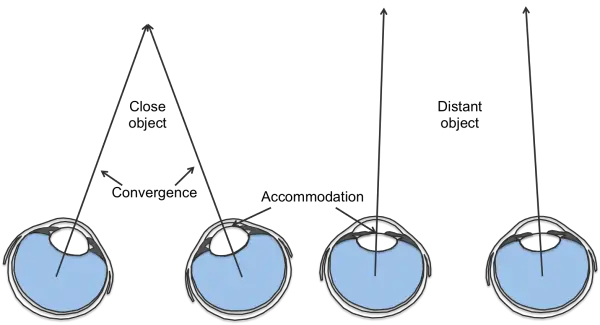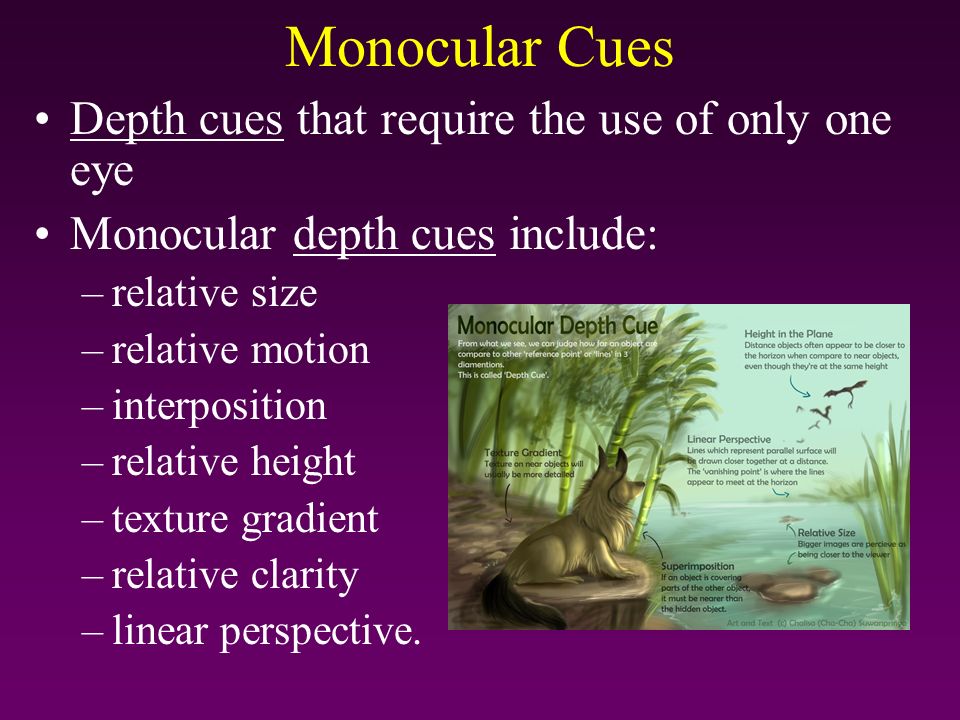Depth Cues Which Require the Use of Only One Eye
Monocular depth cues requires the use of only one eye to provide information to the brain about depth and distance. Depth cues that require only one eye are known as depth cues - ScieMce Depth cues that require only one eye are known as depth cues More questions like this Oculomotor cues help us make inferences about depth and distance by using.

Perception Lecture Notes Depth Size And Shape
One uses cues involving only one eye.

. Monocular Cues are used to help perceive depth by only using one eye. Monocular binocular linear perspective accommodating. Binocular depth cues require the use of both eyes working together in order to provide information to the brain about depth and distance.
Depth cues are often categorised into two groups Binocular which requires the use of both eyes or Monocular which requires the use of only one eye. Most depth cues are monocular in natureb. Axons from the _____ are bundled together.
A monocular cue is a visual cue for depth perception that only requires one eye. These cues are especially important in determining the distance of objects that are relatively close. Because of this many of these cues are used in art to create the illusion of depth in a two-dimensional space.
The second requires two eyes. One such cue the relative motion of objects at different distances can be a powerful cue to depth but is unavailable to the painter. Which type of specialized neuron first collects information from the rods and cones.
The ability to still engage in tasks that require depth perception shows that a. Marko Teittinen The human visual system interprets depth in sensed images using both physiological and psychological cues. Artists use these cues to help portray depth in their work and create a more realistic creation.
The depth perception cues that require the use of only one eye are called. Perception of motion requires only one eye and is thus monocular. When something is far from us we rely on monocular cues those that require the use of only one eye.
Which cue is most important for depth perception. Some physiological cues require both eyes to be open binocular others are available also when looking at images with only one open eye monocular. Monocular cues can play an important role in the detection of depth in the world around us.
While depth perception results primarily from our sense of vision our sense of hearing also plays a role. _____ depth cues require the use of both eyesmonocularbinocularlinear perspectiveaccommodating cue that requires only one eye. C singular vision cues.
The depth perception cues that require the use of only one eye are called. 739 Distance cues that require the use of only one eye are called_____ cues. G120kinesthetic Incorrect g120monocular True Answer Correct g120binocular Incorrect g120vestibular Incorrect.
When something is far from us we rely on monocular cues those that require the use of only one eye. Depth Cues in the Human Visual System Author. Convergence and retinal disparity.
The the artist is even more limited than say television or movies which use moving pictures. Distance cues that require the use of only one eye are called _____ cues. If you were to stare at a green dot for a relatively long period of time and then shift your gaze to a.
Convergence is the amount the eyes converge in words when looking at an object the greater the inward strain. The ability to perceive depth seems to exist early in life. Unlike binocular cues which involve the use of both eyes monocular cues only require the use of one eye and can be presented in two dimensions.
Up to 24 cash back Depth cues are sources of information from the environment or from within our body that help us to perceive how far away objects are and therefore to perceive depth. Stereoscopic vision is only slightly better for judging depth than is accommodation. Stereopsis cannot occur monocularly and is due to binocular retinal disparity within Panums fusional space.
Research with infants has revealed that by two. Depth cues that require both eyes to provide information about depth and distance. There are many types of cues for example.
740 You notice a red car and a white car parked next to each other in a parking lot. So this question is looking at depth cues and which depth cues we can use when we only have one eye. Stereopsis is an important binocular cue to depth perception.
Unlike binocular cues which involve the use of both eyes monocular cues only require the use of one eye and can be presented in two dimensions. Depth cues that require the use of only one eye. Even if you only have one eye you would still be able to drive a car or land an airplane.
All of the other cues to depth are called monocular or one-eye. You perceive the red car as being closer to youbecause it blocks part of. Consequently if for some reason our vision is limited to the use of only one eye tasks requiring us to focus on detail over short.
Relative size 1 If two objects are similar in size we perceive the one that casts a smaller image to be farther away Interposition 2 A monocular depth cue referring to the fact that if one object partially blocks our view of another we perceive it as closer to us. An example of a monocular absolute depth cue is accommodation. Relative size interposition aerial perspective linear perspective texture gradient and motion parallax.
_____ depth cues require the use of both eyes. Two broad classes of cues used to aid visual depth perception have been distinguished the monocular requiring only one eye and the binocular requiring both eyes working together. For closer objects we use both monocular cues and binocular cues those that necessitate both eyes.
So to answer this question will look at the definitions of the following so the texture ingredient is the distortion perceived in size and objects closer and farther away. For closer objects we use both monocular cues and. Monocular Cues Visual cues that only need one eye to be perceived Closure The tendency to perceive a complete or whole figure even though gaps exist Binocular Cues Visual cues that require both eyes to be perceived Stroboscopic Motion The use of the rapid progression of still images or objects to produce the illusion of movement Retinal Disparity.

How Far Away Is It Depth Perception Ppt Video Online Download

Binocular Cues Vs Monocular Cues The Ultimate Guide Definition Difference Uses

Perception Lecture Notes Depth Size And Shape Lectures Notes Perception Cognitive Psychology
Belum ada Komentar untuk "Depth Cues Which Require the Use of Only One Eye"
Posting Komentar